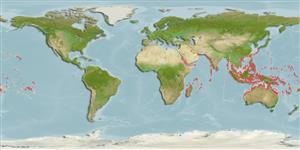Bivalvia |
Cardiida |
Psammobiidae
Environment: milieu / climate zone / djupintervall / distribution range
Ekologi
; brackvatten; djupintervall 0 - 20 m (Ref. 348). Tropical; 31°N - 33°S, 30°E - 137°W
Indo-Pacific: from East Africa, including Madagascar, the Red Sea, Persian Gulf and Andaman Sea, to eastern Polynesia; north to Japan and south to central Queensland and New Caledonia.
Length at first maturity / Size / Weight / Age
Könsmognad: Lm 2.5 range ? - ? cm Max length : 11.0 cm SHL hane/ej könsbestämd; (Ref. 348); common length : 6.5 cm SHL hane/ej könsbestämd; (Ref. 348)
Average edible weight is at 9 g (Ref. 351). Maximum depth from Ref. 75831. Littoral and sublittoral to a depth of about 20 m (Ref. 345). Found in intertidal areas in sand (Ref 75831). Deeply buried in sand, often coarse to gravel bottoms (Refs. 345, 126564). In general, suspension feeding bivalves mainly depend on phytoplankton and detritus material for nutrition (Ref. 107088).
Life cycle and mating behavior
Könsmognad | Reproduktion | Lek | Eggs | Fecundity | Larvae
Mass spawning occurs in late summer and larval stage is about 14 days (Ref. 351).
Poutiers, J.M. 1998 Bivalves. Acephala, Lamellibranchia, Pelecypoda. p. 123-362. In Carpenter, K. E. and V. H. Niem. 1998. FAO species identification guide for fishery purposes. The living marine resources of the Western Central Pacific. Volume 1. Seaweeds, corals, bivalves, and gastropods. Rome, FAO. (Ref. 348)
IUCN Red List Status
(Ref. 130435: Version 2025-1)
CITES status (Ref. 108899)
Not Evaluated
Not Evaluated
Threat to humans
Harmless
Human uses
Fiskeri: kommersiell
| FishSource | Sea Around Us
Verktyg
Ytterligare information
Population dynamicsTillväxtMax. ages / sizesLength-weight rel.Length-length rel.Length-frequenciesMass conversionAbundans PhysiologySyreförbrukning
Human RelatedStamps, coins, misc.
Internet-källor
Estimates based on models
Preferred temperature
(Ref.
115969): 25 - 29.3, mean 28.4 (based on 3504 cells).
Fishing Vulnerability
Low vulnerability (10 of 100).
Price category
Unknown.
Nutrients : Calcium = 149 [71, 228] mg/100g; Iron = 8.53 [1.95, 15.11] mg/100g; Protein = 9.88 [8.64, 11.12] %; Omega3 = 0.313 [0.202, 0.423] g/100g; Selenium = 61 [50, 72] μg/100g; VitaminA = 0 μg/100g; Zinc = 2.04 [0.56, 3.51] mg/100g (wet weight); based on
nutrient studies.
